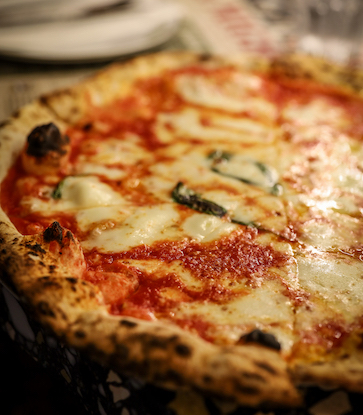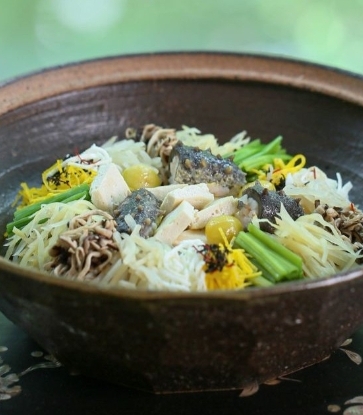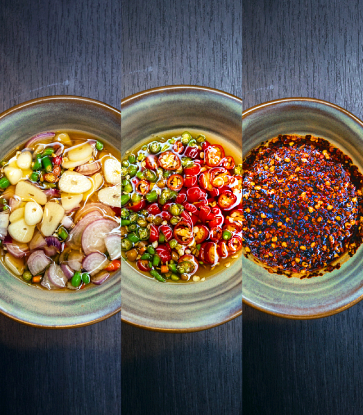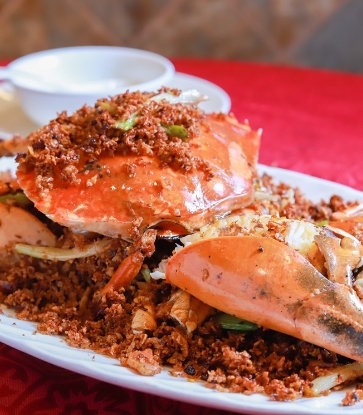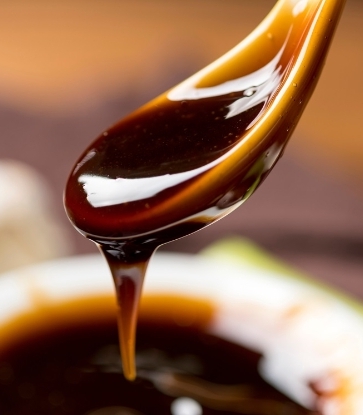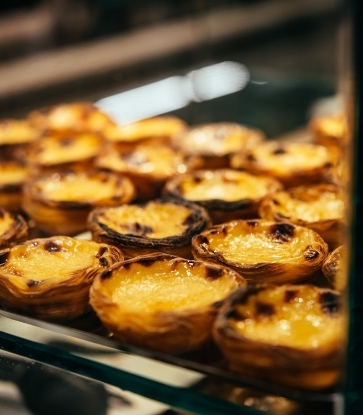Hong Kong boasts a rich culinary tradition revolving around the Lunar New Year. This not only includes dishes carrying auspicious messages and high-end ingredients, but also those bite-sized delights that bring joy to families and friends in between meals. Each of candied fruit, melon seed and chocolate gold coin, sitting in separates compartments of a chuen hup, the festive candy box signifying “completeness”, has their fans. And deep-fried items such as taro fritter, laughing sesame cookie and sesame sticky rice ball are perennial favourites among chit-chatting and mahjong-playing individuals at a Lunar New Year party. Their gilded exterior might be a symbol of wealth, but it is their aroma and crunch that appeal to their consumers the most.
RELATED: Lucky Lunar New Year Recipes from MICHELIN-Starred Restaurant Chefs

With the Year of Snake just around the corner, we invited Li Yuet Faat, executive chef of Chinese cuisine at Cordis, Hong Kong and one-MICHELIN-star Ming Court (Mong Kok), to share his thoughts on all the festive snacks. As someone with a sweet tooth, he adored candied winter melon, candied water chestnut and candied lotus seed which were affordable to families with relatively little means like his. Even if he has largely avoided sweets dues to his age, he would still indulge in the restaurant’s homemade fried sliced lotus root and caramelised walnut in small doses around the Lunar New Year as a way to immerse himself in the festive vibes.
RELATED: The Ultimate Shopaholic's Guide to Hong Kong: Kowloon
While almost all celebratory foods are available in the market now, most of them were prepared at home back in the days. Li, for instance, recalled how his seniors had laboured in the kitchen to prepare nin gou (cane sugar pudding) and yau gok (sweet fried dumpling). Every household has its own recipes, resulting in slightly different looks and tastes which reveal one’s distinct family history and the heartfelt wishes of the maker.
To let our readers try their hand at preparing Lunar New Year snacks, Li demonstrated the cooking methods of taro fritter and sweet fried dumpling.

Taro Fritter
Taro fritter’s Cantonese name wu ha confusingly means “taro shrimp” in literal terms. In reality, it is totally shrimp-free, and the name instead refers to the long, thin, curly strips of taro that resemble the crustacean’s antennae. They had been served as such originally, and were rolled into a sphere only after people noticed how easily they got crushed. Much like its shape, taro fritter’s longevity had been hanging by a thread. The labour-intensive snack looked destined to be phased out by our fast-paced society but experienced a small revival most recently. Still, finding it at a shop is still a challenge, which is even more reason to fry it yourself. The balls’ exquisite shape and intense taro fragrance will surely win you some compliments from visitors!Ingredients
Taro (1/2)Salt (4g)
Sugar (4g)
Sesame oil (droplets)
Five spice powder (a pinch)
Glutinous rice flour and rice flour

Preparation
1. Remove the skin of the taro and rinse it. Dry it with a paper towel and cut into thin ribbons.2. Toss the taro strips with salt and sugar. Let them marinate for 15 minutes until softened.
3. Season the taro with sesame oil and five spice powder.
4. Mix rice flour and glutinous rice flower in a bowl. Use just enough of it to coat the strips. Shape them into small spheres.
5. Pour oil halfway through a wok. Heat it up and test the oil temperature with a chopstick. Once small bubbles form around it, you can drop the spheres inside.
6. Deep-fry them at medium-low (about 120ºC) until the fritters look golden and crispy.
Tips
1. Pick a taro that feels plump, dry and light with little hair at the root. The cross-section near the root should be a light powdery white, with purple streaks in between.2. Use two small hotpot ladles for easier shaping: after adding the flour coating, place a few taro strips into a ladle and put another ladle on top to cover. Take care to not press the ribbons too hard, as they need enough space in between to cook evenly.
3. As a creative twist, Li recommends adding dried silver fish or sakura shrimp to the fritter balls to imbue them with marine umami.
4. For those who are averse to deep-fried food, air-fried taro fritters can be a healthier alternative: Brush all the taro strips with oil before rolling them into spheres. Air-fry the balls at 180ºC for 10 to 15 minutes, depending on the model and size of the machine. Flip them over and fry them for two more minutes, so they are evenly cooked.

Sweet Fried Dumpling
Sweet fried dumpling, or yau gok, offers more substance than brittle taro fritter. It is stuffed with as much filling as possible to resemble a purse bursting with cash, or the boat-shaped gold ingot used in Imperial China Imperial China known as yuanbao. Hongkongers of a certain age all remember preparing the dumpling with their family, chewing the fat at the table as they kneaded the dough and folded the edges of the pastry – any topic or word considered unlucky was strictly forbidden though. A part of the finished dumplings was kept home for guest reception, with another was distributed among neighbours to build excitement for the big day.Ingredients
Dough
Cake flour (450g)Egg, beaten (2)
Water (190g)
Lard (150g)
Filling
Crushed peanut (150g)Shredded coconut (75g)
White sesame (38g)
Sugar (75g)

Preparation
1. Mix the flour with egg and water. Add lard and continue mixing until a dough is formed.2. Shape the dough into a sphere. Cover it with cling film and let it rest for an hour.
3. Roast the shredded coconut, white sesame and peanut separately, crushing the latter into small pieces. After they cool down, mix them together with sugar until fully incorporated.
4. Roll out the rested dough to 2mm thick. Use a mould to cut up wrappers of 7cm in diameter.
5. Place a teaspoon of filling on the wrapper. Fold the wrapper to make it half moon shape, pressing the two ends together to seal it up. Pinch the edges to make pleats.
6. Add oil to the wok. Heat it up and test the oil temperature with a chopstick. Once small bubbles form around it, you can drop the dumplings inside.
7. Fry the dumplings on medium-low heat (around 120ºC, do not let the temperature go higher than that). Keep pushing them around in the oil until they become golden.
Tips
1. If using an air-fryer, brush oil on the surface of the dumplings and fry them at 180ºC for five to eight minutes, depending on the model of the machine.2. Both taro fritters and sweet fried dumplings can be stored at room temperature for up to two weeks. When cooked, let them cool completely and place in a sealed bag or an airtight container to avoid contact with moisture. They can also be kept in a freezer for over a month. Simply bake them in the oven before eating to crisp them up again.
Tea Pairing
When it comes to beverages, tea is often an ideal companion to deep-fried items, as it effectively neutralises the grease in our food. From a flavour perspective, picking the right tea for each snack creates a new dimension of the whole tasting experience. According to Nobel Li, Ming Court’s sommelier who has researched tea extensively, high mountain oolong from Taiwan is refreshing and perfumed with floral notes, which makes it a great match to the salty taro fritter. The tea’s mild sweetness can even accentuate taro’s natural taste.As for sweet fried dumpling, its richness calls for something bolder like aged pu’er. The earthy and wooden notes of the black tea help cut through the heaviness and make each ingredient in the filling stand out.
All photos courtesy of Ming Court (Mong Kok).
RELATED: Restaurant Secrets: Michelin Chefs Reveal Their "Golden Ratio" For Cantonese Turnip Cake



